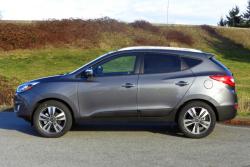 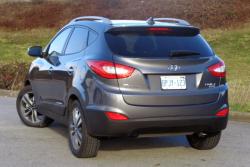 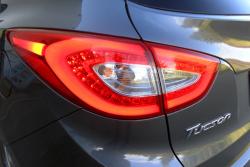 2014 Hyundai Tucson Limited AWD. Click image to enlarge |
Review and photos by Greg Wilson
We’ve been spending a lot of time with the Hyundai Santa Fe Sport lately – it’s proved popular with our reviewers in Autos.ca’s recent compact sport-ute comparison tests – but to be honest, it’s been distracting us from Hyundai’s other compact sport ute, the Tucson (Hyundai likes to call it a compact utility vehicle or CUV) which we last test-drove in 2011. Redesigned in 2010, the curvy European-designed Tucson (and its corporate cousin the Kia Sportage) is a bit smaller than popular CUVs like the Honda CR-V and Ford Escape, but nevertheless has a roomy passenger cabin, generous standard equipment, nimble driving manners, and attractive aerodynamic styling which seems to be holding up quite well after four years (at least in my view). Its main drawback is a comparatively small cargo area.
You’ll be hard-pressed to spot the styling differences for 2014, but there are some minor changes: new LED daytime running lights, projector headlights, and new-style 17 and 18-inch alloy wheels. As well, some trim levels are now available with Hyundai’s driver-selectable variable steering effort system, third generation audio and navigation system, LED tail lights and heated second row seats.
Under the hood, new direct fuel injection has been added to both its available four-cylinder engines to increase power and torque, though it hasn’t done much for fuel economy. The base 2.0L four-cylinder GDI engine (offered in the GL trim) has the same horsepower (164) as last year, but adds five lb-ft of torque (now 151 lb-ft.) for improved mid-range throttle response. Its advertised fuel economy with standard front-wheel drive and the optional six-speed automatic transmission is now 8.9 city/6.9 hwy (L/100 km), but I prefer to use the EPA’s more realistic estimate of 10.2 city/8.1 hwy (23/29 US mpg). That’s a slight overall improvement over the previous engine’s 10.7/8.1 (23/29), but it’s not nearly as thrifty as the Mazda CX-5 2.0 with 9.0/7.4 (26/32), or even the Toyota RAV4 2.5 with 9.8/7.6 (24/31) and the Honda CR-V 2.4 with 10.2/7.6 (23/31) (all models with front-wheel drive and automatic transmission).
The Tucson’s bigger 2.4L four-cylinder GDI engine (offered in the GLS and Limited trims) now delivers six more horsepower (182) and nine more lb-ft of torque (177), but its fuel consumption has increased slightly to 11.8/9.4 (20/25) from 11.8/8.7 (20/27) (equipped with automatic transmission and all-wheel drive) . That’s not as good as the Mazda CX-5 2.5 with 9.8/7.8 (24/30), the Honda CR-V 2.4 with 10.7/7.8 (22/30), the Ford Escape 1.6 Turbo with 10.7/7.8 (22/30), and the Toyota RAV4 2.5 with 10.7/8.1 (22/29) (all with automatic transmissions and all-wheel drive).
Another change from 2013: the standard five-speed manual transmission in the base L trim has been replaced by a six-speed manual in the GL trim, which is now the base trim; the L trim has been discontinued along with its sub $20,000 price-tag.
For its 2014 base price of $21,499 plus a rather hefty $1,760 Freight charge, the Tucson GL FWD includes the 164 hp 2.0L engine and six-speed manual transmission ($23,749 with the six-speed automatic), air conditioning, remote keyless entry, cruise control, heated front cloth seats, Bluetooth hands-free phone, power windows, locks and heated mirrors, AM/FM radio with CD, auxiliary and USB ports (satellite radio with automatic transmission), audio controls on the steering wheel, folding rear seatbacks, traction and stability control, Hill Start Assist, Downhill Brake Control, four disc brakes and 17-inch tires and steel wheels. Tucson GL models with all-wheel drive (AWD) and standard automatic transmission start at $25,749.
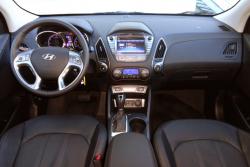 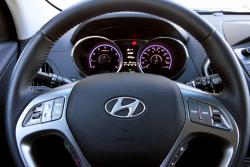 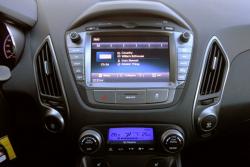 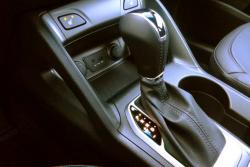 2014 Hyundai Tucson Limited AWD. Click image to enlarge |
The mid-level Tucson GLS trim upgrades to the 184 hp 2.4L engine and standard automatic transmission for $26,899 (FWD) and $28,899 (AWD). To the GL’s list of standard equipment, the GLS adds 17-inch alloy wheels, dual panoramic sunroofs, leatherette seat bolsters to the cloth seats, leather-wrapped steering wheel and shift lever, telescopic steering wheel, back-up camera in the rear-view mirror, heated rear seats, driver’s automatic up/down power window, and automatic head lights.
The top model is the Tucson Limited ($33,599) which comes only with the 2.4L engine, automatic transmission and all-wheel drive as standard equipment. To the GLS’s features, it adds standard 18-inch all-season tires and alloy wheels, LED tail lights, leather seats, power driver’s seat with power lumbar, seven-inch touchscreen with navigation and back-up camera, 4.2-inch information display in the instrument cluster, dual-zone automatic climate control driver selectable steering effort, premium 360-watt audio system with amplifier and seven speakers, Homelink garage door opener, and solar glass.
During the week I had our Tucson Limited tester, it rained – but the day before I had to return it to the manufacturer, it snowed. Woo hoo! What better way to test the Tucson’s all-wheel drive and lockable centre differential, anti-lock brakes, traction and stability control, Downhill Brake Control, Hill Start Assist, and its 18-inch Dunlop Graspio (I chuckle whenever I hear this) winter tires. The steep snow-covered hills in the area where I live proved no problem for the Tucson – it powered up slippery hills and bit into the turns and side slopes without losing much grip. In more demanding road conditions like deep snow, slick ice, gravel roads and so on, the Tucson’s driver-selectable centre differential lock apportions engine power equally to the front and rear wheels. Our Tucson maintained traction and stability in deep snow similar to what a Low Range gear might do. I was also impressed with our Tucson’s Dunlop Graspio (chuckle) snow tires which really seemed to grip the newly fallen snow, however I didn’t have chance to test them on ice.
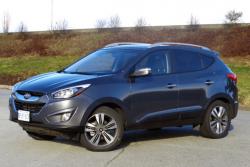 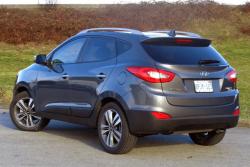 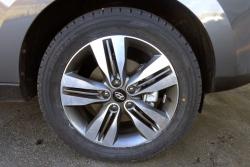 2014 Hyundai Tucson Limited AWD. Click image to enlarge |
But what impressed me the most was the Downhill Brake Control. Descending a very steep, slippery hill, I pressed the button for the DBC and took my foot off the brake: using the ABS system and wheel speed sensors, DBC automatically pumps the brakes faster than the driver can, slowing the Tucson to a crawl. The Tucson didn’t slip and slide sideways as it might have if I’d used the brakes myself – it just trundled down the hill in a controlled fashion. Amazingly, this feature is standard on even the base Tucson.
Another Tucson feature I liked is the Tucson’s short front and rear overhangs: the angled lower front bumper surface won’t act like a snow plough when traversing deep snow. And the Tucson’s decent 6.5-inch ground clearance helps when driving on unploughed roads.
On dry roads, the Tucson’s on-demand all-wheel drive system is basically invisible to the driver; it operates in front-wheel drive most of the time to save fuel and seamlessly engages the rear wheels when the front wheels start to lose grip.
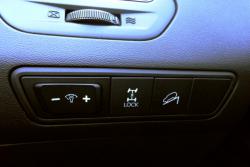 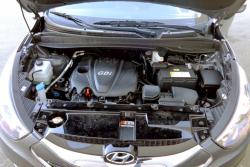 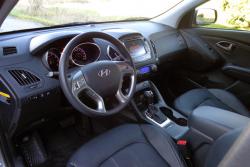 2014 Hyundai Tucson Limited AWD. Click image to enlarge |
Out on the highway, the Tucson has a confident, stable ride that’s firm but not overly harsh. Its fully independent suspension includes front McPherson struts and rear multi-links that provide sure-footed handling with minimal lean in fast corners and stable straight-line tracking. Extra credit must go to the Limited model’s ‘Sachs’ shock absorbers that automatically adjust to road surfaces, and its beefier 225/55R18-inch tires.
Around town, the Tucson’s compact footprint, tight 10.6 metre turning diameter and electro-hydraulic rack and pinion steering, make it easy to manoeuvre in tight spaces, but its poor over-the-shoulder visibility is a hindrance when changing lanes or parallel parking. Fortunately, there is a back-up camera image displayed in the centre screen for reversing into a parking space, and the rear window features an intermittent rear wiper for clearing rain, snow and ice.
Limited models include Driver Selectable Steering Mode which consists of three steering effort levels: Comfort, Normal and Sport. Comfort mode offers a 10 percent decrease in effort from Normal mode which can be handy for parallel parking, and Sport mode increases effort by 10 percent for driving at higher speeds. But the system doesn’t provide any more steering feel and we never really felt a need to change from the standard steering effort level.
We’d recommend the optional 2.4L engine rather than the base 2.0L powerplant because even the bigger engine isn’t that powerful. 0 to 60 mph times published by Consumer Reports show the 182 hp Hyundai Tucson 2.4L AWD with six-speed automatic transmission taking 9.7 seconds. For comparison, the 185-hp Honda CR-V takes 9.2 seconds, the 173 hp Ford Escape 1.6L Turbo 9.9 seconds, and the lightweight 184 hp Mazda CX-5 2.5L just 8.0 seconds. The 2.4L engine has a raspy growl when accelerating, but settles down to a low hum at freeway speeds – the engine revs under 2,000 rpm at a steady 100 km/h. Some tire noise does penetrate the cabin though. The Tucson’s automatic transmission shifts smartly and smoothly and has a manual shift mode for those who prefer to choose their shift points.
Braking performance is good, according to Consumer Reports tests: equipped with four disc brakes, ABS, and Brake Assist, the Tucson can stop on a dry road from 60 mph in 39.3 m (129 ft.). That compares to the CR-V with 39.0 m (128 ft.), Escape 40.5 m (133 ft.) and CX-5 (40.5 m) 133 ft.
Even though it’s shorter in length than the CR-V and Escape, the Tucson offers slightly more passenger volume – but at the expense of trunk volume. Though the Tucson’s cabin is narrow, front and rear legroom and headroom is generous for such a small vehicle and access is fairly easy. In our Tucson Limited model, the standard heated leather seats (front and rear), driver’s power height, tilt and lumbar adjustments, padded centre armrest, and thick-rimmed tilt and telescopic steering wheel provided a very comfy environment for the driver and front passenger. However, the outboard rear seat cushions are rather hard and the elevated centre seating position is even more uncomfortable.
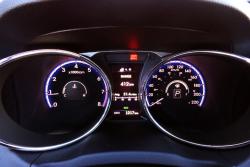 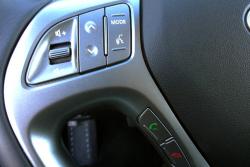 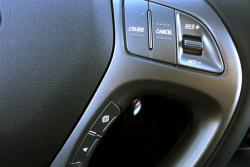 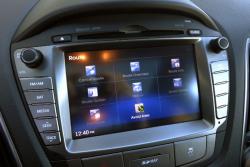 2014 Hyundai Tucson Limited AWD. Click image to enlarge |
We liked the Tucson’s brightly illuminated round gauges and information display behind the steering wheel, the illuminated control buttons on the dash and steering wheel (with the notable exception of the power mirrors), the easy-to-reach centre stack controls and shift lever, and the large centre touch-screen with its numerous functions including audio, navigation, phone, vehicle information. Smart phones and music devices can be hooked up to iPod, USB or auxiliary ports in the lower centre console and wireless Bluetooth phone and audio is standard in the Tucson. The Limited trim features a premium 360-watt audio system with external amplifier and seven speakers which really added to the enjoyment of our daily commute – and Limited models come with standard satellite radio.
During winter, the automatic climate control with separate driver and passenger temperature controls will satisfy a driver who’s too hot and a passenger who’s too cold; and on a cold morning in a car with leather upholstery, the front and rear seat heaters are especially appreciated. On gloomy winter days, the dual sunroofs in the Limited model provide plenty of natural light in the cabin.
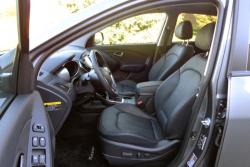 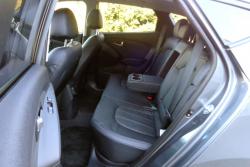 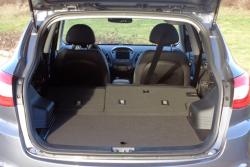 2014 Hyundai Tucson Limited AWD. Click image to enlarge |
Behind the rear seat, the Tucson’s cargo volume of 728 litres is about 25 percent smaller than the Escape’s 971 litres and the CR-V’s 1,054 litres. With both rear seats folded, the Tucson’s maximum cargo volume of 1,580 litres compares to the Escape’s 1,920 litres and the CR-V’s 2,007 litres. There is some extra space under the trunk floor next to the spare tire. We did like the easy-to-lift hatch and large cargo opening, but while the trunk floor is carpeted, the side walls are exposed plastic.

























Overall, we liked the Tucson’s compact size, nimble handling, contemporary styling, and all-weather capability – and while it doesn’t offer the biggest trunk or the best fuel economy in its class, those aren’t necessarily deal breakers if you like the way it drives – which we did.
Pricing: 2014 Hyundai Tucson Limited AWD
Base price (GL 2.0 FWD Man): $21,499
Base price (Limited 2.4 AWD): $33,599
Freight: $ 1,760
A/C tax: $ 100
Price as tested: $35,459
Competitors:
Chevrolet Equinox, Trax
Ford Escape
Honda CR-V
Jeep Patriot
Kia Sportage
Mazda CX-5
Nissan Rogue
Subaru Forester
Toyota RAV4
VW Tiguan
Crash Test Results:
National Highway Traffic Safety Administration (NHTSA)
Insurance Institute for Highway Safety (IIHS)











